
Glencairn is a castle-like mansion in Bryn Athyn, Pennsylvania, that was home to the Pitcairn family for more than 40 years. Now the Glencairn Museum, it contains a collection of about 8,000 artworks, mostly religious in nature, from cultures such as ancient Egypt, ancient Greece, the Roman Empire and medieval Europe, as well as Islamic, Asian, and Native American works. The museum is affiliated with The New Church, and the building is on the National Register of Historic Places.
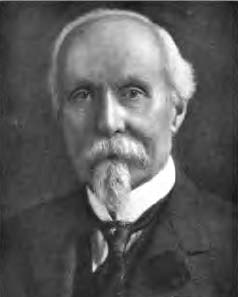
John Pitcairn Jr. was a Scottish-born American industrialist. With just an elementary school education, Pitcairn rose through the ranks of the Pennsylvania railroad industry, and played a significant role in the creation of the modern oil and natural gas industries. He went on to found the Pittsburgh Plate Glass Company, an early industry innovator which quickly grew into the largest manufacturer of plate glass in the United States, and amassed one of the largest fortunes in the United States at the time.
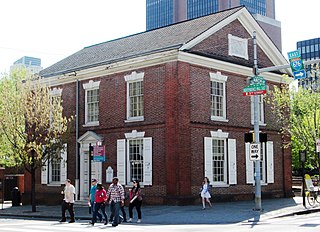
The Free Quaker Meetinghouse is a historic Free Quaker meeting house at the southeast corner of 5th and Arch Streets in the Independence National Historical Park in Philadelphia, Pennsylvania. It was built in 1783, and is a plain 2 1⁄2-story brick building with a gable roof. The second floor was added in 1788. The building was moved about 30 feet to its present site in 1961, to allow for the widening of Fifth Street.

The Bryn Athyn Historic District is a National Historic Landmark District encompassing an important collection of Arts and Crafts movement architecture in Bryn Athyn, Montgomery County, Pennsylvania. Designated in 2008, it includes three residential properties associated with the Pitcairn family who supported the movement, as well as Bryn Athyn Cathedral, all built by craftsmen employed by the Pitcairns.

The Quakertown Passenger and Freight Station is a historic train station and freight depot located at Quakertown, Bucks County, Pennsylvania. The two buildings were designed by Wilson Bros. & Company in 1889 and built by Cramp and Co. for the Philadelphia and Reading Railroad in 1902. The passenger station is constructed of dark Rockhill granite and Indiana limestone and is in a Late Victorian style. It is 1+1⁄2 stories tall and measures 25 feet wide by 97 feet 6 inches, long. It has a hipped roof with an eight-foot overhang. The freight station is a 1+1⁄2-story, rectangular stone block building measuring 128 by 30 feet. Also on the property is a large crane that was used for freight movement. The Quakertown station had passenger rail service along the Bethlehem Line to Bethlehem and Philadelphia until July 27, 1981, when SEPTA ended service on all its intercity diesel-powered lines. SEPTA still owns the line and leases it to the East Penn Railroad. Other towns, stations, and landmarks on the Bethlehem Line are Perkasie, Pennsylvania, Perkasie Tunnel, and Perkasie station.

Connellsville Union Passenger Depot, also known as the Connellsville Pittsburgh & Lake Erie Station, is a historic railway station located at Connellsville, Fayette County, Pennsylvania. It was built between 1911 and 1912 by the Pittsburgh and Lake Erie Railroad and Western Maryland Railway. It is a 1 1/2-story, rectangular brick building measuring 109 feet by 28 feet. It features a three-story tower, wide overhanging eaves, and hipped roofs on the building and tower covered in blue-green Spanish terra cotta tiles. It is in an American Craftsman style of architecture. It ceased use as a passenger station in 1939, after which it housed a car dealership and auto parts store. It was purchased by the Youghiogheny Opalescent Glass Company in the spring of 1995.

Cairnwood is a 26,000 square feet (2,400 m2) historic home located adjacent to the Glencairn Museum in Bryn Athyn, Montgomery County, Pennsylvania. It was designed by the architectural firm of Carrère and Hastings and built in 1895. The surrounding grounds were designed by Olmsted, Olmsted and Eliot. It was built for John Pitcairn, Jr. (1841–1916), President of Pittsburgh Plate Glass Company. It is a 2½-story, Roman brick and limestone French country estate home in the Beaux Arts style. The L-plan house has 28 rooms, plus a chapel in the third story turret. Also on the property are a contributing stable and garden house built contemporary to the main house, and garage complex (1911). A contributing structure is the estate wall. The property is now owned by the Academy of the New Church and serves as a special events facility, specifically hosting weddings, corporate functions, fundraising and social events of all kinds.
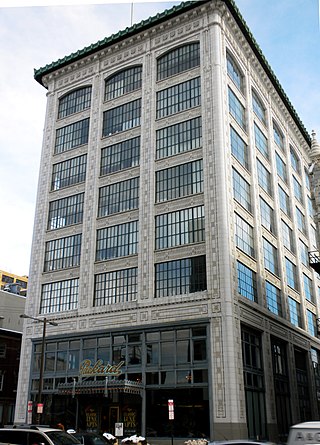
The Packard Motor Car Company Building, also known as the Press Building, is an historic, American office building that is located at 317–321 North Broad Street between Pearl and Wood Streets in the Callowhill neighborhood of Philadelphia, Pennsylvania.

The New York Mutual Life Insurance Company Building, also known as the Victory Building, is an historic, American office building that is located in the Market East neighborhood of Philadelphia, Pennsylvania.

The Old Federal Reserve Bank Building is an historic, American bank building that is located at 925 Chestnut Street, on the corner of South 10th Street, in the Market East neighborhood of Philadelphia, Pennsylvania.
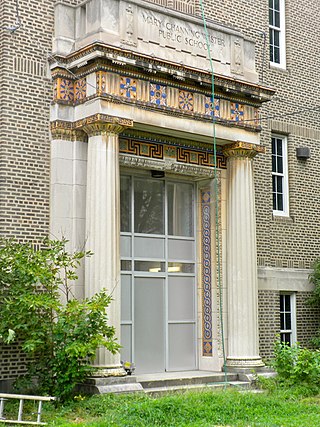
The Mary Channing Wister School, originally the Mary Channing Wister Public School, is an historic, American school building that is located in the Poplar neighborhood of Philadelphia, Pennsylvania.

William W. Axe School is a historic school building located in the Frankford neighborhood of Philadelphia, Pennsylvania. It was designed by Lloyd Titus and built in 1903–1904. It is a two-story, three-bay, stone building on a raised basement in the Colonial Revival style. It has a one-story, rear brick addition. It features stone lintels and sashes and a projecting center section with gable.

Charles W. Henry School is a historic school located at 601 Carpenter Lane in the Mount Airy neighborhood of Philadelphia, Pennsylvania. It is part of the School District of Philadelphia. The building was designed by Henry deCourcy Richards and built by Cramp & Co. in 1906–1908. It is a two-story, 20 bay, red brick building in the Colonial Revival-style. Additions were built in 1949–1950 and 1968. It features arched entryways and limestone trim. It was the scene of a bombing during its construction in 1906.
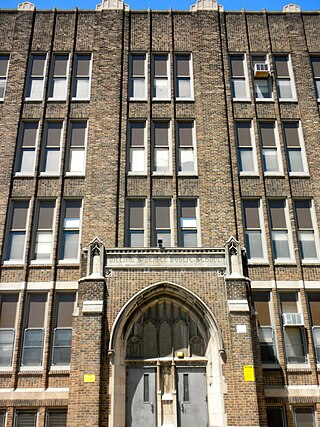
William S. Peirce School is a historic school building located in the Southwest Center City neighborhood of Philadelphia, Pennsylvania. It was designed by Irwin T. Catharine and built in 1928–1929. It is a four-story, nine bay, brick building on a raised basement in the Late Gothic Revival-style. It features pilasters with limestone caps and a projecting entrance pavilion with an arched opening.
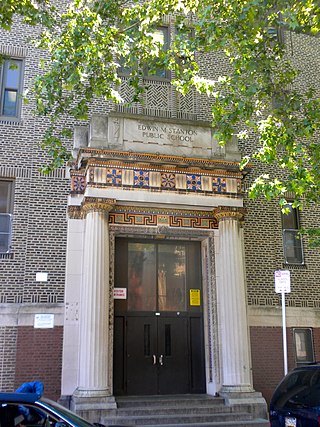
Edwin M. Stanton School is an historic K-8 school located in the Southwest Center City neighborhood of Philadelphia, Pennsylvania, within the Christian Street Historic District. It is part of the School District of Philadelphia.

Grays Road Recreation Center is an historic recreation center, which is located in the Grays Ferry neighborhood of Philadelphia, Pennsylvania.

Franklin Hose Company No. 28, also known as Harmony Engine Company No. 6, is a historic fire station located in the Southwest Center City neighborhood of Philadelphia, Pennsylvania. It was originally built about 1849, and considerably altered with a new front in 1868-1869. It is a four-story, three bay wide building measuring 34 by 60 feet. It is constructed of brick, with an ashlar granite faced first story and a mansard roof. It features round arched window openings and a heavy wood cornice. In February 2010, the building was undergoing renovation.

The Hardy Williams Academy, formerly the Anna Howard Shaw Junior High School is an historic junior high school building which is located in the Southwest Schuylkill neighborhood of Philadelphia, Pennsylvania.

Parkway West High School' is an American public magnet high school that is located in the Mill Creek neighborhood of Philadelphia, Pennsylvania. It shares a site with the Middle Years Alternative School for the Humanities (MYA). Both schools are part of the School District of Philadelphia.
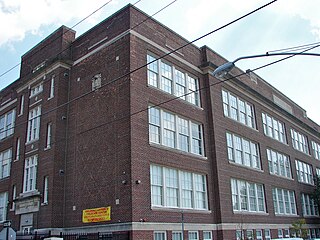
Holmes Junior High School is an historic junior high school building, which is located in the West Philadelphia neighborhood of Philadelphia, Pennsylvania, United States.


























